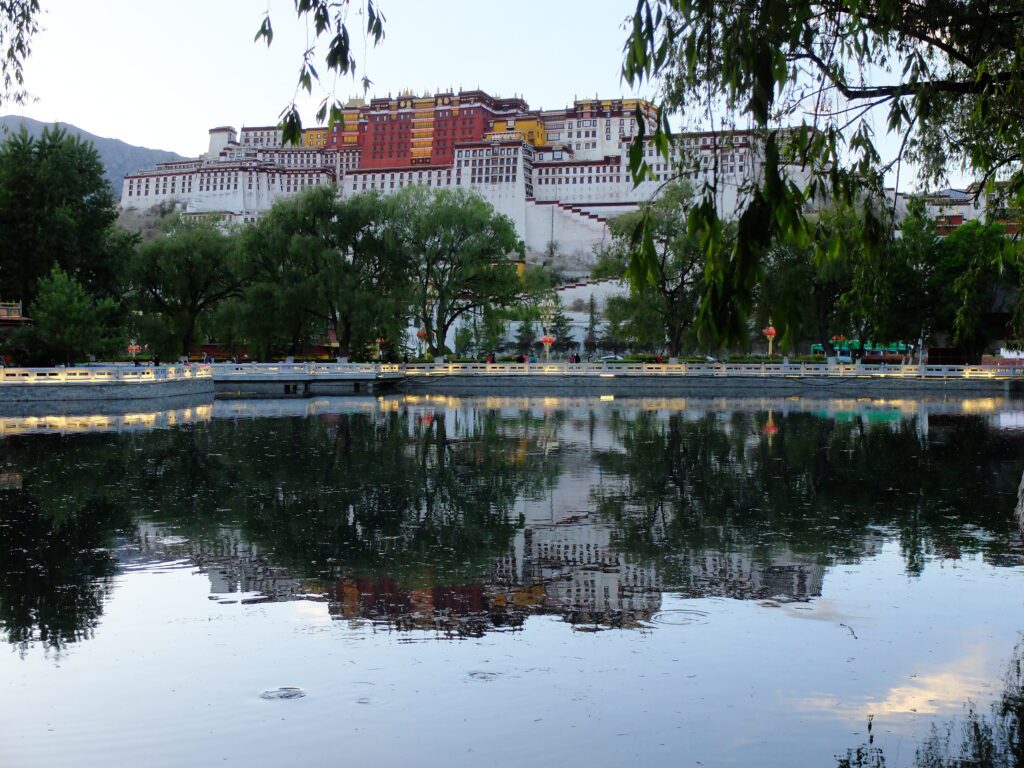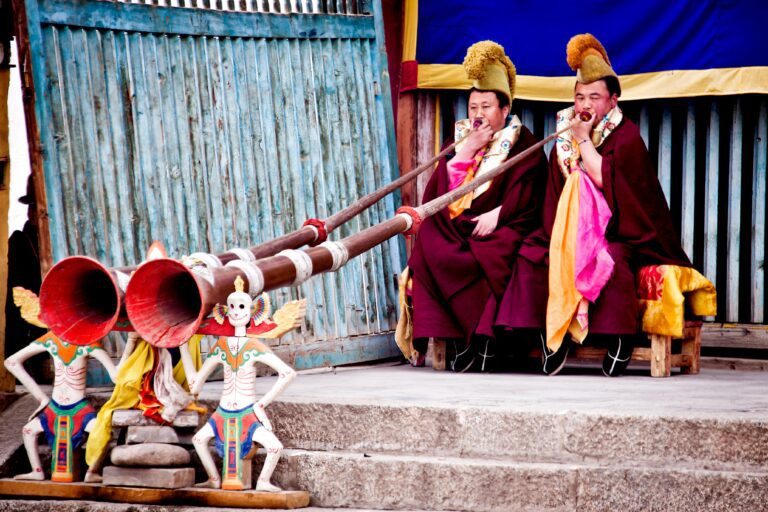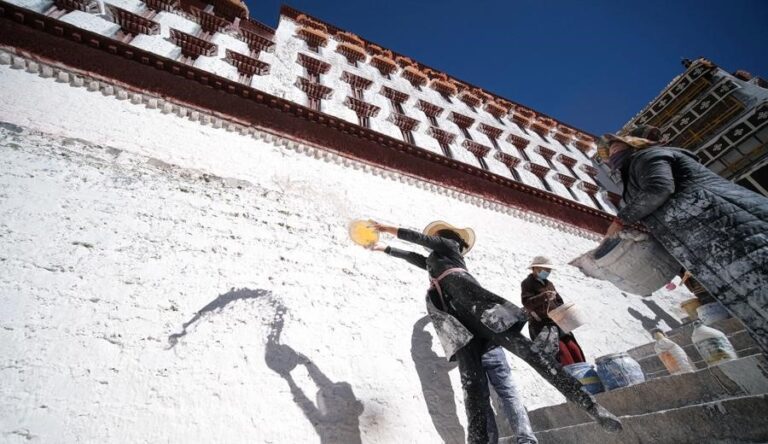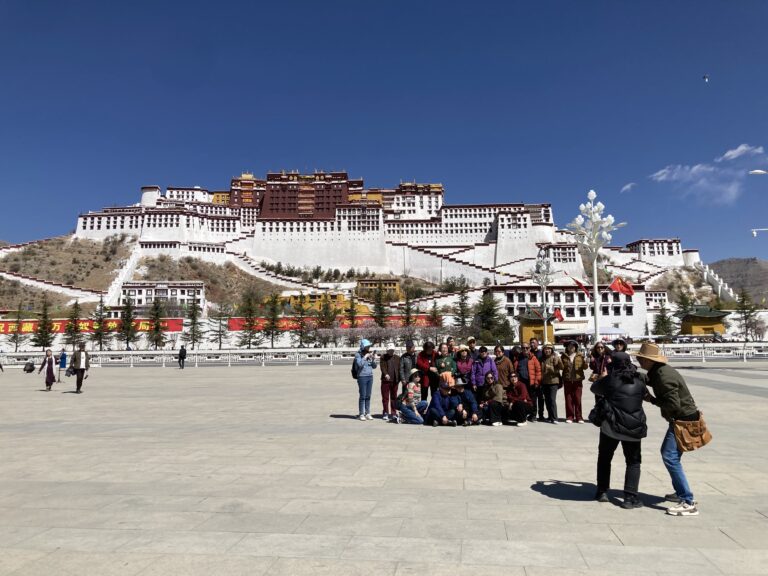Rising majestically above the city of Lhasa at 3,700 meters above sea level, the Potala Palace stands as one of the world’s most recognizable architectural marvels and the ultimate symbol of Tibetan Buddhism. This UNESCO World Heritage Site, once the winter residence of the Dalai Lama, represents over 1,300 years of Tibetan history, spirituality, and artistic achievement. For travelers embarking on a spiritual journey through Tibet, no destination is more essential or awe-inspiring than this magnificent palace in the sky.
A Monument to Tibetan Buddhism
The Potala Palace serves as far more than just a historic building – it embodies the very essence of Tibetan Buddhist culture and tradition. Built in the 7th century and extensively expanded in the 17th century, this architectural masterpiece stands as the highest building in Lhasa, commanding breathtaking panoramic views of the city and surrounding mountains.
With over 1,000 rooms, 10,000 shrines, and 200,000 statues, the Potala Palace represents one of the most comprehensive collections of Tibetan Buddhist art and artifacts in the world. Every corner of this magnificent structure tells a story of devotion, artistic excellence, and spiritual dedication that has been carefully preserved for centuries.
The Architectural Marvel
The Ascent to Enlightenment
Visiting the Potala Palace begins with a symbolic journey upward – ascending approximately 1,000 stairs that lead to the palace’s main structures. This climb, while physically demanding at high altitude, serves as both a practical necessity and a spiritual metaphor for the journey toward enlightenment in Buddhist philosophy.
The palace complex consists of two main sections: the White Palace and the Red Palace. The White Palace served as the administrative and residential quarters, while the Red Palace housed the spiritual chambers, chapels, and tombs of past Dalai Lamas. The distinctive red and white exterior walls create a striking visual contrast against the deep blue Tibetan sky, making the palace visible from great distances across the Lhasa valley.
Interior Treasures and Sacred Spaces
Inside the Potala Palace, visitors encounter an overwhelming display of Tibetan artistic achievement. The intricate artwork, magnificent architecture, and rich history combine to create an educational and deeply moving experience. The palace houses countless treasures, including:
- Sacred Manuscripts: Ancient texts written on palm leaves and traditional paper
- Golden Statues: Magnificent Buddha statues crafted from precious metals
- Intricate Murals: Wall paintings depicting Buddhist teachings and Tibetan history
- Religious Artifacts: Prayer wheels, ceremonial objects, and ritual items
- Royal Chambers: The preserved living quarters of the Dalai Lamas
Each room within the palace serves a specific purpose, from meditation halls to libraries, administrative offices to private chapels. The preservation of these spaces offers modern visitors an authentic glimpse into the daily life of Tibet’s spiritual and temporal leader.
Historical Significance
Origins in the 7th Century
The Potala Palace’s history begins in the 7th century when King Songtsen Gampo first established a palace on this site. The strategic location, known as Marpo Ri (Red Hill), was chosen for its commanding position overlooking the Lhasa valley and its spiritual significance in Tibetan cosmology.
The palace we see today, however, primarily dates from the 17th century when the Fifth Dalai Lama ordered its reconstruction and expansion. This massive undertaking required thousands of workers and artisans, taking over 50 years to complete. The result was a structure that would serve as the political and spiritual center of Tibet for centuries.
The Dalai Lama’s Winter Palace
For nearly 300 years, the Potala Palace served as the winter residence of successive Dalai Lamas, Tibet’s spiritual and temporal leaders. The palace functioned as both a monastery and a government seat, housing monks, administrators, and servants who maintained the complex operations of Tibetan governance and religious practice.
The palace’s role extended beyond mere residence – it served as the center of Tibetan political power, the site of important religious ceremonies, and a place of pilgrimage for Buddhists from across the Himalayan region. The Dalai Lama would spend winters here conducting affairs of state, receiving visitors, and participating in religious observances.
Spiritual Significance and Religious Practice
A Living Temple
Despite its status as a museum and tourist destination, the Potala Palace remains an active site of religious practice. Tibetan pilgrims continue to visit the palace to pay their respects, offer prayers, and participate in religious ceremonies. The sight of devotees prostrating themselves before sacred statues and spinning prayer wheels adds a profound spiritual dimension to any visit.
The palace houses numerous chapels and shrines dedicated to different Buddhist deities and historical figures. Each space maintains its religious significance, with monks and caretakers ensuring that traditional practices continue alongside tourism activities.
Connection to Avalokiteshvara
According to Tibetan Buddhist belief, the Dalai Lama is considered the earthly manifestation of Avalokiteshvara, the bodhisattva of compassion. The Potala Palace, as the Dalai Lama’s residence, therefore holds special significance as the earthly dwelling place of this compassionate deity. This spiritual connection elevates the palace beyond mere historical importance to a site of active religious veneration.
Visiting the Potala Palace Today
Planning Your Visit
Visiting the Potala Palace requires advance planning and preparation. The site has strict visitor limits to preserve the structure and artifacts, making reservations essential, especially during peak tourist seasons. The palace is typically included in comprehensive Tibet tours, such as the 4-Day Lhasa Holy City Tour offered by Experience Tibet.
What to Expect
A typical visit to the Potala Palace includes:
- Guided Tour: Expert guides provide historical context and explain the significance of different areas
- Photography Restrictions: Interior photography is strictly limited to preserve artifacts
- Physical Demands: The high altitude and numerous stairs require reasonable physical fitness
- Time Limits: Visits are typically limited to ensure all tourists have access
- Security Measures: Bag checks and metal detectors are standard procedures
Best Times to Visit
The ideal time to visit the Potala Palace is during the morning hours when lighting conditions are optimal for photography and crowds are generally smaller. The palace is particularly beautiful during the golden hours of sunrise and sunset when the white and red walls glow against the mountain backdrop.
The Palace in Context: Lhasa’s Holy City Tour
Integration with Other Sacred Sites
The Potala Palace forms the cornerstone of any comprehensive exploration of Lhasa’s spiritual sites. A typical holy city tour combines the palace with other essential locations:
- Jokhang Temple: Tibet’s most sacred temple, located in the heart of old Lhasa
- Barkhor Street: The ancient pilgrim circuit surrounding Jokhang Temple
- Sera Monastery: Famous for its monk debates and religious education
- Drepung Monastery: Once the world’s largest monastery
This combination provides visitors with a comprehensive understanding of Tibetan Buddhism and culture, from the political and spiritual authority represented by the Potala Palace to the grassroots religious practice visible at neighborhood temples and markets.
Conservation and Preservation
UNESCO World Heritage Status
The Potala Palace’s designation as a UNESCO World Heritage Site in 1994 recognizes its outstanding universal value and ensures international support for its preservation. This status brings both opportunities and challenges, as the site must balance conservation needs with tourism access and ongoing religious use.
Modern Conservation Efforts
Significant resources are dedicated to maintaining the palace’s structural integrity and preserving its precious artifacts. Conservation work includes:
- Structural Reinforcement: Ensuring the ancient building can withstand seismic activity
- Climate Control: Protecting artifacts from temperature and humidity fluctuations
- Visitor Management: Limiting numbers to reduce wear on floors and structures
- Traditional Craftsmanship: Using authentic materials and techniques for repairs
Photography and Artistic Inspiration
Capturing the Palace’s Beauty
The Potala Palace offers countless opportunities for stunning photography, from sweeping panoramic shots to detailed architectural elements. The best viewpoints include:
- Chagpo Ri Hill: Offers classic frontal views of the palace
- Dragon King Pool: Provides reflection shots during calm weather
- Various Rooftops: In old Lhasa offer unique perspectives
- Palace Courtyards: Interior shots (where permitted) capture architectural details
Artistic and Cultural Impact
The Potala Palace has inspired countless artists, photographers, and writers over the centuries. Its distinctive silhouette has become synonymous with Tibet itself, appearing on everything from postage stamps to tourism posters. The palace’s influence extends far beyond Tibet, inspiring architectural elements in Buddhist temples worldwide.
Practical Information for Visitors
Preparation Tips
To make the most of your Potala Palace visit:
- Acclimatize Properly: Spend at least one full day in Lhasa before visiting
- Dress Appropriately: Modest clothing and comfortable walking shoes are essential
- Bring Water: Stay hydrated at high altitude
- Respect Photography Rules: Follow all restrictions regarding cameras
- Allow Sufficient Time: Plan for at least 2-3 hours for a comprehensive visit
Understanding the Experience
Visiting the Potala Palace is both educational and deeply moving. The combination of artistic beauty, historical significance, and spiritual atmosphere creates an experience that resonates long after your visit ends. Many travelers describe their time at the palace as transformative, providing new perspectives on Tibetan culture and Buddhist philosophy.
Conclusion: A Journey to the Heart of Tibet
The Potala Palace stands as more than just a tourist attraction – it represents the spiritual heart of Tibet and the enduring legacy of Tibetan Buddhist civilization. From its commanding position above Lhasa, this magnificent structure continues to inspire visitors with its architectural beauty, historical significance, and profound spiritual atmosphere.
Whether you’re drawn by architectural interest, spiritual curiosity, or cultural exploration, the Potala Palace delivers an unforgettable experience that captures the essence of Tibet’s unique heritage. As you climb those thousand steps and explore the countless rooms filled with treasures, you’ll gain insights into a civilization that has maintained its spiritual focus despite centuries of change and challenge.
For travelers seeking to understand Tibet’s cultural heritage and spiritual traditions, the Potala Palace remains an essential destination that provides context and meaning to the entire Tibetan experience. Plan your visit as part of a comprehensive holy city tour and prepare for an encounter with one of the world’s most remarkable architectural and spiritual achievements.








